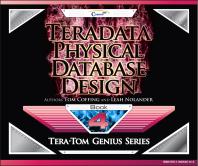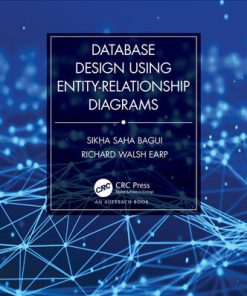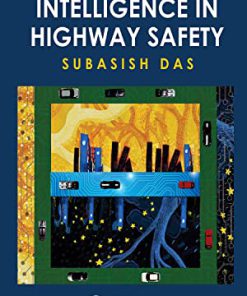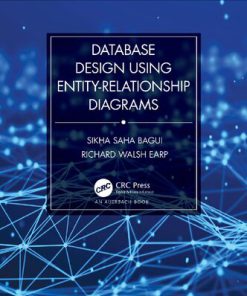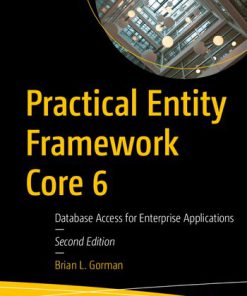Database Design Using Entity Relationship Diagrams 3rd Edition by Sikha Saha Bagui, Richard Walsh Earp 103201718X 9781032017181
$50.00 Original price was: $50.00.$25.00Current price is: $25.00.
Database Design Using Entity Relationship Diagrams 3rd Edition by Sikha Saha Bagui, Richard Walsh Earp – Ebook PDF Instant Download/Delivery: 103201718X, 9781032017181
Full download Database Design Using Entity Relationship Diagrams 3rd Edition after payment
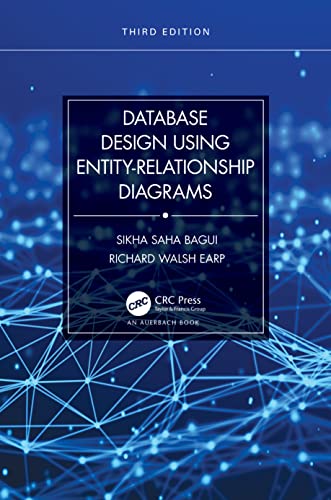
Product details:
ISBN 10: 103201718X
ISBN 13: 9781032017181
Author: Sikha Saha Bagui, Richard Walsh Earp
Essential to database design, entity-relationship (ER) diagrams are known for their usefulness in data modeling and mapping out clear database designs. They are also well-known for being difficult to master. With Database Design Using Entity-Relationship Diagrams, Third Edition, database designers, developers, and students preparing to enter the field can quickly learn the ins and outs of data modeling through ER diagramming. Building on the success of the bestselling first and second editions, this accessible text includes a new chapter on the relational model and functional dependencies. It also includes expanded chapters on Enhanced Entity-Relationship (EER) diagrams and reverse mapping. It uses cutting-edge case studies and examples to help readers master database development basics and defines ER and EER diagramming in terms of requirements (end user requests) and specifications (designer feedback to those requests), facilitating agile database development. This book Describes a step-by-step approach for producing an ER diagram and developing a relational database from it Contains exercises, examples, case studies, bibliographies, and summaries in each chapter Details the rules for mapping ER diagrams to relational databases Explains how to reverse engineer a relational database back to an entity-relationship model Includes grammar for the ER diagrams that can be presented back to the user, facilitating agile database development The updated exercises and chapter summaries provide the real-world understanding needed to develop ER and EER diagrams, map them to relational databases, and test the resulting relational database. Complete with a wealth of additional exercises and examples throughout, this edition should be a basic component of any database course. Its comprehensive nature and easy-to-navigate structure make it a resource that students and professionals will turn to throughout their careers.
Database Design Using Entity Relationship Diagrams 3rd Table of contents:
Chapter 1 Data, Databases, and the Software Engineering Process
1.1 Introduction
1.2 Data
1.3 Building a Database
1.4 What Is the Software Engineering Process?
1.5 Entity-Relationship Diagrams and the Software Engineering Life Cycle
1.5.1 Phase 1: Get the Requirements for the Database
1.5.2 Phase 2: Specify the Database
1.5.3 Phase 3: Design the Database
1.6 Chapter Summary
Chapter 1 Exercises
Bibliography
Chapter 2 Data and Data Models
2.1 Introduction
2.2 Files, Records, and Data Items
2.3 Moving From 3 × 5 Cards to Computers
2.4 Database Models
2.4.1 The Hierarchical Model
2.4.1.1 The Hierarchical Model with a Linked List
2.4.1.2 Relationship Terminology
2.4.1.3 Drawbacks of the Hierarchical Model
2.5 The Network Model
2.6 The Relational Model
2.7 Chapter Summary
Bibliography
Chapter 3 The Relational Model and Functional Dependencies
3.1 Introduction
3.2 Fundamentals of Relational Database
3.3 Relational Database and Sets
3.4 Functional Dependency
3.5 Non-1NF to 1NF
3.6 The Second Normal Form
3.6.1 Anomalies
3.6.2 Non-2NF to 2NF
3.7 The Third Normal Form
3.8 The Equijoin Operation
3.9 Some Functional Dependency Rules
3.10 The Boyce–Codd Normal Form
3.11 Chapter Summary
Chapter 3 Exercises
Bibliography
Chapter 4 The Basic ER Diagram: A Data Modeling Schema
4.1 Introduction
4.2 What Is a Data Modeling Schema?
4.2.1 What Is an Entity-Relationship Diagram?
4.3 Defining a Database—Some Definitions: Entity, Relationship, and Attribute
4.3.1 A Beginning Methodology
4.3.2 ER Design Methodology
4.4 A First “Entity-Only” ER Diagram: An Entity with Attributes
4.5 More about Attributes
4.5.1 The Simple or Atomic Attribute
4.5.2 The Composite Attribute
4.5.3 The Multivalued Attribute
4.5.4 The Derived Attribute
4.5.5 Keys
4.6 English Description of the Entity
4.6.1 The Method
4.6.1.1 The Entity
4.6.1.2 The Attributes
4.6.1.3 The Keys
4.6.2 ER Design Methodology
4.6.3 Examples
4.6.3.1 Figure 4.3 Example
4.6.3.2 Figure 4.4 Example
4.6.3.3 Figure 4.5a Example
4.6.3.4 Figure 4.6 Example
4.6.3.5 Figure 4.7 Example
4.7 Mapping the Entity Diagram to a Relational Database
4.8 Chapter Summary
Chapter 4 Exercises
Case Study
Notes
Bibliography
Chapter 5 Beyond the First Entity Diagram
5.1 Introduction
5.2 Examining an Entity: Changing an Attribute to Be an Entity
5.3 Defining a Relationship for Our New Entity
5.3.1 ER Design Methodology
5.4 A Preliminary Grammar for ER Diagrams
5.4.1 The Relationship
5.5 Defining a Second Entity
5.6 Does a Relationship Exist?
5.7 Attribute or Relationship?
5.7.1 ER Design Methodology
5.8 Chapter Summary
Chapter 5 Exercises
Case Study
Bibliography
Chapter 6 Extending Relationships/Structural Constraints
6.1 Introduction
6.2 The Cardinality Ratio of a Relationship
6.2.1 One to One (1:1)
6.2.2 Many to One (M:1)
6.2.3 One to Many (1:M)
6.2.4 Many to Many (M:N)
6.3 Participation: Full/Partial
6.4 English Descriptions
6.5 Tighter English
6.5.1 Pattern 1—x:y::k:1
6.5.2 Pattern 2—x:y::k:1
6.5.3 Pattern 3—x:y::k:M
6.5.4 Pattern 4—x:y::k:M
6.5.5 Summary of the Patterns and Relationships
6.5.5.1 Pattern 1
6.5.5.2 Pattern 1
6.5.5.3 Pattern 2
6.5.5.4 Pattern 2
6.5.5.5 Pattern 3
6.5.5.6 Pattern 3
6.5.5.7 Pattern 4
6.5.5.8 Pattern 4
6.5.6 ER Design Methodology
6.6 Some Examples of Other Relationships
6.6.1 An Example of the One-to-Many Relationship (1:M)
6.6.1.1 Pattern 4–1:M, From the 1 Side, Partial Participation
6.6.1.2 Pattern 2—M(Partial):1, From M Side, Optional Participation
6.6.2 An Example of the Many-to-One Relationship (M:1)
6.6.2.1 Pattern 1—M:1, From the M Side, Full Participation
6.6.2.2 Pattern 3–1:M, From the 1 Side, Full Participation
6.6.3 An Example of the Many-to-Many Relationship (M:N)
6.6.3.1 Pattern 3—M:N, From the M Side, Full Participation
6.6.3.2 Pattern 4—N:M, From the N Side, Partial Participation
6.7 One Final Example
6.7.1 ER Design Methodology
6.7.1.1 The Entity
6.7.1.2 The Entity
6.7.2 Pattern 1—M:1, From the M Side, Full Participation
6.7.3 Pattern 3–1:M, From the 1 Side, Full Participation
6.8 Mapping Relationships to a Relational Database
6.8.1 Mapping Binary M:N Relationships
6.8.2 Mapping Binary 1:1 Relationships
6.8.3 Mapping Binary 1:N Relationships
6.9 Chapter Summary
Chapter 6 Exercises
Case Study
Note
Bibliography
Chapter 7 The Weak Entity
7.1 Introduction
7.2 Strong and Weak Entities
7.3 Weak Entities and Structural Constraints
7.4 Weak Entities and the Identifying Owner
7.4.1 Another Example of a Weak Entity and the Identifying Owner
7.5 Weak Entities Connected to Other Weak Entities
7.6 Revisiting the Methodology
7.7 Weak Entity Grammar
7.7.1 The Keys
7.8 Mapping Weak Entities to a Relational Database
7.9 Chapter Summary
Chapter 7 Exercises
Case Study
Bibliography
Chapter 8 Further Extensions for ER Diagrams with Binary Relationships
8.1 Introduction
8.2 Attributes of Relationships
8.2.1 The Attributes
8.3 Relationships Developing into Entities: The M:N Relationship Revisited
8.3.1 The Entity
8.3.1.1 The Attributes
8.3.1.2 The Keys
8.4 More Entities and Relationships
8.4.1 More Than Two Entities
8.4.1.1 Pattern 4—x:y::1:M, From the 1 Side, Partial Participation
8.4.1.2 Pattern 1—x:y::M:1, From the M Side, Full Participation
8.4.2 Adding More Attributes That Evolve into Entities
8.5 More Evolution of the Database
8.6 Attributes That Evolve into Entities
8.7 Recursive Relationships
8.7.1 Recursive Relationships and Structural Constraints
8.7.1.1 One-to-One Recursive Relationship (Partial Participation on Both Sides)
8.7.1.2 One-to-Many Recursive Relationship (Partial Participation on Both Sides)
8.7.1.3 Many-to-Many Recursive Relationship (Partial on Both Sides)
8.8 Multiple Relationships
8.9 The Derived or Redundant Relationship
8.10 Optional: An Alternative ER Notation for Specifying Structural Constraints on Relationships
8.11 Review of the Methodology
8.11.1 ER Design Methodology
8.11.2 The Entity
8.11.2.1 The Attributes
8.11.2.2 The Keys
8.12 Mapping Rules for Recursive Relationships
8.13 Chapter Summary
Chapter 8 Exercises
Case Study
Bibliography
Chapter 9 Ternary and Higher-Order ER Diagrams
9.1 Introduction
9.2 Binary or Ternary Relationship?
9.3 Structural Constraints for Ternary Relationships
9.3.1 Many to Many to Many (M1:M2:M3)
9.4 An Example of an n-ary Relationship
9.5 n-ary Relationships Do Not Preclude Binary Relationships
9.6 Methodology and Grammar for the n-ary Relationship
9.6.1 A More Exact Grammar
9.6.1.1 Pattern 3—M:N, From the M Side, Full Participation
9.6.1.2 Pattern 3—k:M, from the k Side, Full Participation (k = 1 or N)
9.6.1.3 Pattern 5 (n-ary)—x:y:z::a:b:c, From the a Side, Full/Partial Participation
9.6.2 Grammar in a Partial Participation, Ternary Relationship with an M1:1:M2 Relationship
9.7 Ternary Relationships From Relationship-Relationship Situations
9.8 n-ary Relationships That May Be Resolved into Binary Relationships
9.9 Mapping n-ary Relationships to a Relational Database
9.10 Review of the Methodology
9.10.1 ER Design Methodology
9.11 Chapter Summary
Chapter 9 Exercises
Bibliography
Chapter 10 The Enhanced Entity-Relationship (EER) Model
10.1 Introduction
10.2 What Is a Generalization or Specialization?
10.3 Variants
10.4 Examples of Generalizations or Specializations
10.5 Methodology and Grammar for Generalization/Specialization Relationships
10.6 Mapping Rules for Generalizations and Specializations
10.6.1 Mapping Rule 15
10.6.2 Mapping Rule 16
10.6.3 Mapping Rule 17
10.6.4 Mapping Rule 18
10.7 Subclasses of Subclasses
10.7.1 Mapping Rule 19
10.8 Categories or Union Types
10.8.1 Participation Ratios in Categories or Union Types
10.8.2 Mapping Categories or Union Types When Superclasses Have the Same Primary Keys
10.8.3 Mapping Categories or Union Types When Superclasses Have Different Primary Keys
10.9 Final ER Design Methodology
10.9.1 ER Design Methodology
10.10 Chapter Summary
Chapter 10 Exercises
Case Study
Bibliography
Chapter 11 Relational Mapping and Reverse Engineering ER/EER Diagrams
11.1 Introduction
11.2 Steps Used to Map ER/EER Diagrams to Relational Databases
11.3 Reverse Engineering
11.3.1 Reverse Engineering Rule 1. Develop Strong Entities
11.3.2 Reverse Engineering Rule 2. Look for 1:1 and 1:N (1:x) Relationships
11.3.3 Reverse Engineering Rule 2a. Check for Attributes of the 1:x Relationship
11.3.4 Reverse Engineering Rule 3. Look for Weak Entities and Multivalued Attributes
11.3.5 Reverse Engineering Rule 3a. Checking for Weak Entities
11.3.6 Reverse Engineering Rule 3b. Checking for Multivalued Attributes
11.3.7 Reverse Engineering Rule 4. Check for M:N and n-ary Relationships
11.3.8 Reverse Engineering Rule 4a. Check for the Binary Case
11.3.9 Reverse Engineering Rule 4b. Check for the n-ary Case
11.3.10 Reverse Engineering Rule 5. Check for Generalization/Specialization Relationships
11.3.11 Reverse Engineering Rule 5a. Check for Generalization/Specialization Relationships with Disjoint or Overlap Relationships with Total or Partial Participation Constraints
11.3.12 Reverse Engineering Rule 5b. Check for Disjoint Generalization/Specialization Relationships with Single-Predicate-Defined Attributes
11.3.13 Reverse Engineering Rule 5c. Check for Overlap Generalization/Specialization Relationship with More Than One Flag
11.3.14 Reverse Engineering Rule 6. Check for Shared Subclasses
11.3.15 Reverse Engineering Rule 7. Check for Categories or Union Types
11.4 Chapter Summary
Chapter 11 Exercises
Bibliography
Chapter 12 A Brief Overview of the Barker/Oracle-Like Model
12.1 Introduction
12.2 A First “Entity-Only” ER Diagram: An Entity with Attributes
12.3 Attributes in the Barker/Oracle-Like Model
12.3.1 Optional versus Mandatory Attributes
12.4 Relationships in the Barker/Oracle-Like Model
12.5 Structural Constraints in the Barker/Oracle-Like Model
12.6 Dealing with the Concept of the Weak Entity in the Barker/Oracle-Like Model
12.7 Dealing with the Concept of Multivalued Attributes in the Barker/Oracle-Like Model
12.8 Treatment of Foreign Keys
12.9 Recursive Relationships in the Barker/Oracle-Like Model
12.10 Mapping M:N Relationships
12.11 Chapter Summary
Chapter 12 Exercises
People also search for Database Design Using Entity Relationship Diagrams 3rd:
visual studio code entity relationship diagram
relational database diagram symbols
database relational diagram
sql entity relationship diagram
Tags:
Sikha Saha Bagui,Richard Walsh Earp,Database,Design
You may also like…
Psychology - Clinical Psychology
Using Diagrams in Psychotherapy A Guide to Visually Enhanced Therapy 1st Edition Charles M. Boisvert
Computers - Databases
Database Design Using Entity Relationship Diagrams Third Edition Sikha Saha Bagui
Medicine - Diabetes
Atlas of Diabetes Mellitus, 4e (Dec 29, 2023)_(1032379456)_(CRC Press) 4th Edition Scobie
Computers - Databases
Database Design Succinctly 1st Edition by Joseph D Booth ISBN 9781642002232 1642002232
Uncategorized
Artificial Intelligence in Highway Safety 1st Edition by Subasish Das ISBN 9780367436704 0367436701
Computers - Databases
Database Design Using Entity Relationship Diagrams 3rd Edition S. Bagui
Computers - Enterprise Computing Systems
Practical Entity Framework Core 6: Database Access for Enterprise Applications Brian L. Gorman




